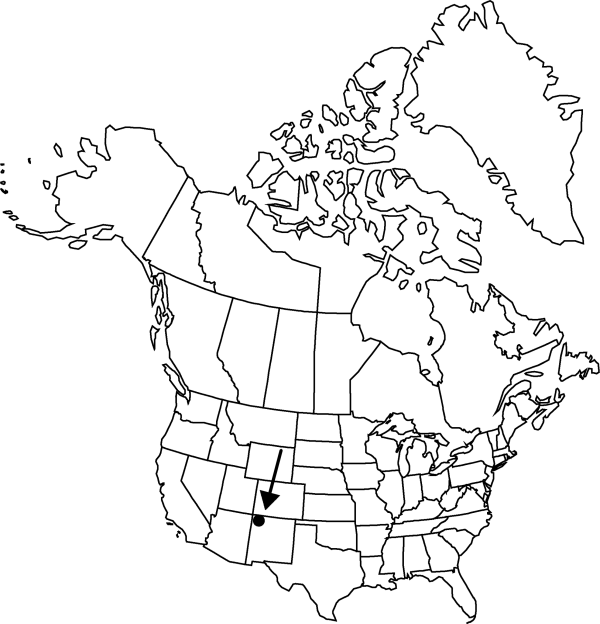Difference between revisions of "Abronia bolackii"
Novon 12: 167, fig. 1. 2002.
FNA>Volume Importer |
FNA>Volume Importer |
||
| Line 16: | Line 16: | ||
}}<!-- | }}<!-- | ||
| − | --><span class="statement" id="st- | + | --><span class="statement" id="st-undefined" data-properties=""><b>Plants </b>perennial, short caulescent or nearly acaulescent. <b>Stems</b> decumbent to erect, minutely and sparsely glandular-pubescent or ± glabrate, arising from cordlike rhizomes. <b>Leaves</b>: petiole 1–4 cm; blade elliptic-oblong to ovate, 1–4 × 0.5–2 cm, margins entire to shallowly sinuate, often ± undulate, surfaces minutely puberulent or glabrous (especially in age). <b>Inflorescences</b>: peduncle longer than subtending petiole; bracts broadly lanceolate, ovate, obovate, or almost round, 5–10 × 3–10 mm, scarious, apex acute, obutse, or rounded, glandular-puberulent; flowers 15–25. <b>Perianth</b>: tube greenish, 7–11 mm, limb white, 3 mm diam. <b>Fruits</b> broadly turbinate, 5–7 × 3–5 mm, scarious, apex truncate and slightly beaked; wings (3–)5, dilated distally and ± flattened perpendicular to plane of lamina, dilations ± as long as wide, thin walled, cavities extending throughout.</span><!-- |
-->{{Treatment/Body | -->{{Treatment/Body | ||
| + | |phenology=Flowering spring–summer. | ||
|habitat=Gypseous sandy or gravelly soils, open areas, among sparse shrubs | |habitat=Gypseous sandy or gravelly soils, open areas, among sparse shrubs | ||
|elevation=1700 m | |elevation=1700 m | ||
| Line 38: | Line 39: | ||
|basionyms= | |basionyms= | ||
|family=Nyctaginaceae | |family=Nyctaginaceae | ||
| + | |phenology=Flowering spring–summer. | ||
|habitat=Gypseous sandy or gravelly soils, open areas, among sparse shrubs | |habitat=Gypseous sandy or gravelly soils, open areas, among sparse shrubs | ||
|elevation=1700 m | |elevation=1700 m | ||
| Line 45: | Line 47: | ||
|publication year=2002 | |publication year=2002 | ||
|special status= | |special status= | ||
| − | |source xml=https://jpend@bitbucket.org/aafc-mbb/fna- | + | |source xml=https://jpend@bitbucket.org/aafc-mbb/fna-data-curation.git/src/9216fc802291cd3df363fd52122300479582ede7/coarse_grained_fna_xml/V4/V4_123.xml |
|genus=Abronia | |genus=Abronia | ||
|species=Abronia bolackii | |species=Abronia bolackii | ||
| − | |||
| − | |||
| − | |||
| − | |||
| − | |||
| − | |||
| − | |||
| − | |||
| − | |||
| − | |||
| − | |||
| − | |||
| − | |||
| − | |||
| − | |||
| − | |||
| − | |||
| − | |||
| − | |||
| − | |||
| − | |||
| − | |||
| − | |||
| − | |||
| − | |||
| − | |||
| − | |||
| − | |||
| − | |||
| − | |||
| − | |||
| − | |||
| − | |||
| − | |||
}}<!-- | }}<!-- | ||
-->[[Category:Treatment]][[Category:Abronia]] | -->[[Category:Treatment]][[Category:Abronia]] | ||
Revision as of 13:56, 27 July 2019
Plants perennial, short caulescent or nearly acaulescent. Stems decumbent to erect, minutely and sparsely glandular-pubescent or ± glabrate, arising from cordlike rhizomes. Leaves: petiole 1–4 cm; blade elliptic-oblong to ovate, 1–4 × 0.5–2 cm, margins entire to shallowly sinuate, often ± undulate, surfaces minutely puberulent or glabrous (especially in age). Inflorescences: peduncle longer than subtending petiole; bracts broadly lanceolate, ovate, obovate, or almost round, 5–10 × 3–10 mm, scarious, apex acute, obutse, or rounded, glandular-puberulent; flowers 15–25. Perianth: tube greenish, 7–11 mm, limb white, 3 mm diam. Fruits broadly turbinate, 5–7 × 3–5 mm, scarious, apex truncate and slightly beaked; wings (3–)5, dilated distally and ± flattened perpendicular to plane of lamina, dilations ± as long as wide, thin walled, cavities extending throughout.
Phenology: Flowering spring–summer.
Habitat: Gypseous sandy or gravelly soils, open areas, among sparse shrubs
Elevation: 1700 m
Discussion
As far as is known, Abronia bolackii is restricted to gypseous lenses of the Ojo Alamo Formation in San Juan County, New Mexico.
Selected References
None.
